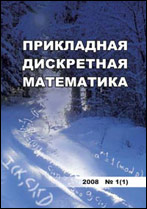|
Theoretical Backgrounds of Applied Discrete Mathematics
On the two definitions of degree of a function over an associative, commutative ring
M. I. Anokhin
Information Security Institute of Lomonosov University, Moscow, Russia
Abstract:
Let $R$ be an associative, commutative ring and let $\varphi\colon R^m\to R$, where $m\ge0$. Denote by $\deg_\Pi\varphi$ the smallest integer $n\ge-1$ such that $\varphi$ can be represented by an $m$-variate polynomial of degree $n$ over $R$. (By convention, the degree of the zero polynomial is $-1$.) Also, let $\deg_\mathrm{RM}\varphi$ denote the smallest integer $n\ge-1$ such that $\partial_{v_1}\dots\partial_{v_{n+1}}\varphi=0$ for all $v_1,\dots,v_{n+1}\in R^m$. Here $(\partial_v\psi)(x)=\psi(x+v)-\psi(x)$ for any $v,x\in R^m$ and any function $\psi\colon R^m\to R$. If no such integer $n$ exists, then we put $\deg_\Pi\varphi=\infty$ or $\deg_\mathrm{RM}\varphi=\infty$, respectively. In this paper, we study the problem of characterizing the class $\mathfrak D$ of all associative, commutative rings $R$ such that these degrees coincide for functions over $R$, i.e., $\deg_\Pi\varphi=\deg_\mathrm{RM}\varphi$ for all $m\ge0$ and all functions $\varphi\colon R^m\to R$. We solve this problem when the additive group $\mathcal R$ of the ring $R$ belongs to some large classes of abelian groups. Namely, our main results are as follows: 1) if $\mathcal R$ is torsion or finitely generated, then $R\in\mathfrak D$ if and only if $R\cong\mathbb Z/d\mathbb Z$ for some square-free integer $d\ge1$; 2) if $\mathcal R$ is not reduced, then $R\in\mathfrak D$ if and only if $R\cong(\mathbb Z/d\mathbb Z)\oplus\mathbb Q$ for some square-free integer $d\ge1$; 3) if $\mathcal R$ is a direct sum of rank $1$ subgroups, then $R\in\mathfrak D$ if and only if $R\cong\mathbb Z/d\mathbb Z$ or $R\cong(\mathbb Z/d\mathbb Z)\oplus\mathbb Q$ for some square-free integer $d\ge1$; 4) if $\mathcal R$ is reduced and cotorsion, then $R\in\mathfrak D$ if and only if $R\cong\prod_{p\in P}(\mathbb Z/p\mathbb Z)$ for some set $P$ of prime numbers. The proof of these results is based on the fact that any ring in $\mathfrak D$ is an $E$-ring.
Keywords:
associative ring, commutative ring, Abelian group, additive group of a ring, polynomial, degree of a function, $E$-ring, Newton's formula.
Citation:
M. I. Anokhin, “On the two definitions of degree of a function over an associative, commutative ring”, Prikl. Diskr. Mat., 2017, no. 37, 5–19
Linking options:
https://www.mathnet.ru/eng/pdm588 https://www.mathnet.ru/eng/pdm/y2017/i3/p5
|

| Statistics & downloads: |
| Abstract page: | 219 | | Full-text PDF : | 80 | | References: | 40 |
|




 Contact us:
Contact us: Terms of Use
Terms of Use
 Registration to the website
Registration to the website Logotypes
Logotypes







 Citation in format
Citation in format 